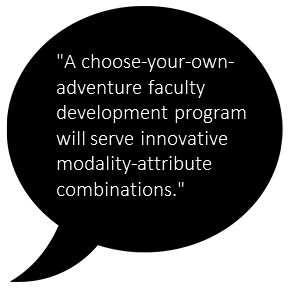Author(s): Dr. Amanda Major
Editor: Dr. Denise Lowe
Dear ADDIE,
The shift to remote teaching during the ongoing pandemic has prompted faculty to deliver creative online experiences for their students, combining different modes of delivery and using new technology tools. My university needs a way of categorizing these different mode options so that faculty will know the parameters of how to deliver their courses, students can make informed course enrollment decisions, and internal staff can have a common language to support faculty and students’ efforts for success. Could you use your decoder expertise and help us decipher between the different modalities?
Signed,
Caesar Cipher
Dear Caesar Cipher,
I can understand your confusion. Students need to understand the course modalities for which they are registering so they may plan their semester schedules or determine if the mode meets their learning preferences or specific life circumstances. Faculty need to know the parameters of each modality so they may deliver the course in a method consistent with students’ expectations. Internal higher education staff, who may support teaching or learning activities, need to have a common language so they can make recommendations consistent with the course modality, technology tools, and instructional techniques that best complement learning experiences.
When many campuses switched to remote learning over late Spring 2019 due to the COVID-19 pandemic, many faculty members unfamiliar with the Learning Management System (LMS) utilized video conferencing sessions or video streaming to deliver their lectures. They learned as quickly as possible how to store their instructional content and create assessments on their institution’s LMS. Some faculty couldn’t help but offer the bare necessities for course delivery, and others found creative ways to deliver their courses, i.e., repurposing a clear shower door as a lightboard during video sessions and creating lab kits customized to the course to send to their students. These examples went above and beyond most faculty members’ efforts, as many faculty spent enormous amounts of mental and physical energy during that unprecedented time managing their own lives, like determining how to school and care for their children while they had to work from home.

As higher education institutions re-opened, administrators introduced HyFlex and BlendFlex modalities as a method for following CDC recommended guidelines and to accommodate stakeholders (parents, students, faculty, local businesses, and others) who have strong needs and preferences for remote or in-person course delivery. In its pure form, HyFlex is conceptualized as a student-directed method because students choose which option suits them best, online or face-to-face instruction. It’s designed to serve on-ground and online students with limited resources, especially relevant for emergency situations, via multi-modal delivery (Beatty, 2019). Essentially a HyFlex approach to learning, BlendFlex affords students the option to seamlessly move between experiences of face-to-face and online synchronous or asynchronous instruction to complete required elements of a course (as described by Carol Lee in Liebermann, 2018). Both modalities imply that there is both an online and face-to-face version of the course designed, developed, and delivered. Empathy is due to faculty, as well as those who guide and support them (project managers, faculty development coordinators and facilitators, instructional technologists, multi-media specialists, and instructional designers), as they attempt to live up to Hyflex and Blendflex ideal standards while also managing extenuating life circumstances during their institution’s campus re-openings.
For these reasons, describing the different modalities in terms of whether instruction has certain space or time requirements, as well as the degree of flexibility between space or time, makes the most sense. The following chart may clarify modality differences, which was inspired from instructional designer dialogue at the University of Central Florida but does not reflect any official definitions from the University.
| Required Elements for Students | ||||
| Modality | Physical classroom | Live, Synchronous Sessions | Online, Asynchronous Instruction | Video, Asynchronous Instruction |
| Blended, Mostly Online | Up to 20% | Possibly* | More than 50% | Possibly* |
| Blended, Face-to-Face | More than 20% | Possibly* | Up to 50% | Possibly* |
| Web-based | No | Optional Only^ | Yes | Possibly* |
| Face-to-face | More than 50% | Possibly* | Optional Only ^ | Optional Only ^ |
| Video | Possibly* | Yes- | Possibly* | Yes- |
| HyFlex | Possibly* | Possibly* | Possibly* | Possibly* |
| Extended Reality | Possibly* | Possibly* | Possibly* | Possibly* |
^ ”Optional only” denotes that the element can be designed/delivered by faculty but must be offered to students as an optional activity, not as a requirement.
-“Video” denotes that completion of synchronous or asynchronous learning activities are required by viewing recorded video. The required amount of each type of learning activity (synchronous or asynchronous) must be communicated to students prior to enrollment so they may schedule their time appropriately.
A quick description of required elements is warranted. The physical classroom requirement means that students and faculty must attend in-person at a physical space on campus. That may include individuals using robotic proxies; live, synchronous streaming; or video recordings for accessibility reasons or excused absences. Often, synchronous sessions substitute for already scheduled face-to-face modes in which a student is required to be physically present. Live, synchronous sessions require students and faculty to be online at the same time but not in the same location, occurring during a video conferencing session, collaborative environment, or video streaming (if not recorded for later viewing definitive of asynchronous video instruction). Asynchronous instruction does not require faculty nor students to be in the same location, at the same time. Typically, online asynchronous instruction is delivered over a platform, such as an LMS, communication platform, or website.
The modality is defined by time and space requirements, i.e., when students must be present and where students must be located to receive instruction. The reason for defining course modes is so students and faculty know where to be and when. For this reason, some would argue that Video and Extended Reality (e.g., as the use of augmented reality like Pokemon Go, mixed reality like via Holo Lens, and extended reality that provides simulated experiences) are attributes of instruction that could occur in any modality, when students are face-to-face, or asynchronously or synchronously interacting.
Attributes offer a common language as well as a set of best practices for faculty and professionals supporting or guiding their efforts to source materials and adapt instruction. Attributes may occur in instances or permeate an entire course. Designers are intimately familiar with these attributes: mastery, experiential, service, gamified, technology enhanced, personalized adaptive, immersive, project based, case based, active, appreciative, inclusive, internationalized, team based, and so on.
The faculty development implications of having a variety of modalities, as well as attributes, provide a smorgasbord of options from which faculty may pick and choose— a decision made best in congruence with their instructional preferences, their students’ preferences, and their program’s niche. For instance, a group of language arts faculty members are designing a series of courses on an adaptive platform so students may enjoy a personalized learning experience that outshines popular language learning apps. These faculty members need to know the basics of instructional design, teaching online courses, and basics of mastery learning. They, however, need more in-depth procedural knowledge about the adaptive platform and associated teaching methods, inclusive teaching and responsive systems design. As another example, for faculty planning to teach online using the institution’s LMS, all they need to know are the essentials of the platform as well as best practices for designing/teaching online. For the outcome of faculty learning nuanced skills to deliver innovative courses, a one-size-fits-all approach to faculty development is no longer relevant. Creating a faculty development ecosystem that supports a program-approved, choose-your-own-adventure credentialing system will serve an array of innovative modality-attribute combinations.
Ultimately definitions for instructional modalities, and support provided for each, must align with the designated accrediting bodies as well as the institutions’ vision, mission, infrastructure, and resources. For other ideas of how instructional modalities may be defined, take a look at Azus Pacific University’s Instructional Modalities, and the University of Central Florida’s Course Modalities and Attributes. For pros and cons of synchronous, asynchronous, and combination courses, see Kansas State University’s Keep Teaching Online Modalities. If you’re re-designing your faculty development ecosystem to enable course innovations across modalities and attributes, you may glean some ideas from TOPkit’s Examples of Faculty Development Pathways.
What other modalities or attributes have you applied or are exploring at your higher education institution? Please share your thoughts with our TOPkit community on LinkedIn!
References
Beatty, B. J. (2019). Hybrid-Flexible Course Design (1st ed.). Ed Tech Books. https://edtechbooks.org/hyflex
Lieberman, M. (January, 2018). Introducing a New(-ish) Learning Mode: Blendflex/Hyflex. Inside Higher Ed: https://www.insidehighered.com/digital-learning/article/2018/01/24/blendflex-lets-students-toggle-between-online-or-face-face
